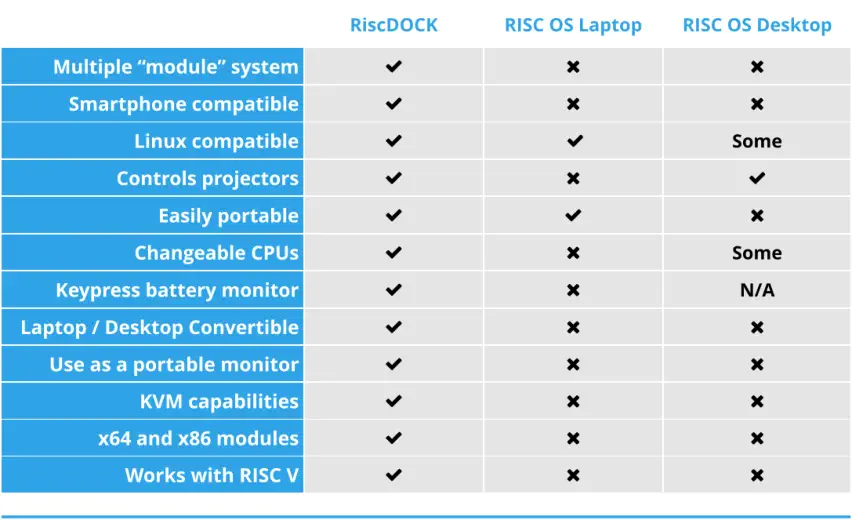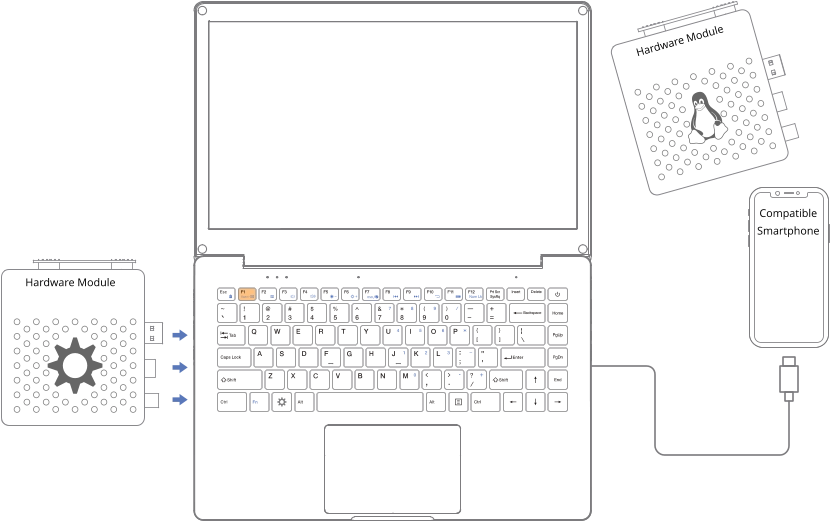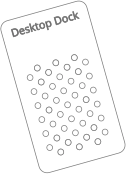1. Isn’t it just a laptop?
No, it’s better described as a modular lapdock. A lapdock is essentially a laptop shell consisting of a
screen, keyboard, trackpad, and battery but without a built-in computer. It becomes functional when
paired with another device which acts as the "brain." In RiscDOCK’s case, this is a docked RISC OS
Computing module. It offers plug-and-play functionality with various devices, requiring no additional
drivers. The integrated keyboard and touchpad provide a familiar and comfortable user experience.
2. What else can it do, that a laptop can’t?
It has several other functions above and beyond those of a traditional laptop
•
It can serve as a portable display for many other computing modules
•
It can act as a KVM, switching smoothly between displaying RISC OS, and Android or iOS, depending on
your smartphone.
•
It can provide a laptop-like experience for making presentations with projectors
•
It can function as a desktop computer, when the RISC OS module is undocked from the cradle
•
It can connect to multiple devices, with multiple OSes, on multiple platforms - try that with a traditional
laptop!
•
You can even watch DVDs on it!
3. Is it future-proof and cost-effective?
Yes! You can upgrade the RISC OS module as newer models are released, or even replace individual
components like the lapdock or accessories without discarding the entire setup. In contrast, RISC OS
laptops traditionally have fixed hardware, making upgrades challenging.
4. How flexible is it?
it is highly versatile and can serve multiple purposes:
•
As a Laptop Replacement: Pair it with a RISC OS module or similar device to create a lightweight,
portable RISC OS workstation.
•
For Smartphone Productivity: Use it with a smartphone, including ones that supports desktop modes
(e.g., Samsung DeX).
•
For Tinkering and Prototyping: Ideal for developers or hobbyists working on single-board computers or
other hardware projects.
A dedicated laptop is locked into its specific use case, while a RiscDOCK adapts to your needs.
5. How powerful is it?
RiscDOCKs provide the portability of a laptop while allowing you to connect more powerful or specialised
devices. This is particularly beneficial when paired with a module running a highly efficient operating
system like RISC OS, or even a smartphone for lightweight computing tasks.
6. How portable is it?
Weighing approximately 1.4 kg and measuring 0.78 inches in thickness, the RiscDOCK is lightweight and
slim, making it easy to carry and ideal for on-the-go use.
7. How good is the software?
RiscDOCK comes complete with s STABLE build of RISC OS, although it can use the cutting edge ”nightly”
builds if required. It will run most modern 32bit RISC OS apps and software. Intensive apps like Iris and
RiscOSM work without problem. WiFi even works “out of the box” for a real “laptop” experience - so you
could couple it with RiscOSM to act as a GPS!
The OS will develop at the same rate as RISC OS does - there’s no reliance on one provider to build
updates.
8. Can the system be customised?
Whereas dedicated laptops come with pre-configured hardware and limited options for customization,
RiscDOCK allows you to:
•
Use a range of RISC OS computing modules
•
Connect peripherals like external storage, USB devices, or additional displays
•
Use it in different configurations, such as with a number of boards, for development work.
9. What processors and platforms can it run RISC OS on?
It can run RISC OS on any 32bit ARM processor that currently works, including:
Cortex A8
Cortex A9
Cortex A15
Cortex A53
Cortex A72
Rock RK3399
Unlike traditional RISC OS laptops, it can also make use of 64bit only ARM chips, RISC-V, x86 and x64
processors and more! Not for RISC OS, but for other OSes, buy hey! As long as it has HDMI and USB, it will
probably work!
10. What’s the price advantage?
For many users, a RiscDOCK combined with a low-cost device like a RISC OS computing module or a
compatible smartphone is more affordable than buying a mid-range or an expensive laptop, while still
providing comparable functionality for many tasks. Plus it’s far cheaper than a traditional RISC OS laptop
of the same specification.
11. What are the use cases for such a device?
a.
We regularly use it as a monitor, keyboard and mouse for development machines, so we don’t have to
keep unplugging our main machine from the monitor and peripherals.
b.
It’s great to keep all of your stuff one one machine - just undock the module and use it as a traditional
desktop machine.
c.
Use it with a simple HDMI 1 in - 2 out splitter to make presentations to projectors whilst watching the
RiscDOCK screen.
d.
Ideal for using your smartphone and RISC OS module at the same time - press a key to switch
between them.
12. If I’ve got a RISC OS laptop, why would I want one of these?
Please read the FAQ again - you’re not paying attention! It is especially good as a replacement device for
an Acorn A4(!), A Pi-Top 1, a Pi-Top 2, and a Pinebook. It’s definitely worth considering if you have a
Pinebook Pro. We’ll even consider trade-ins for some RISC OS devices, just get in touch!
13. It’s not enough… what else can it do?
With extra docking cradles, you could have separate modules for different versions of RISC OS, or even
different versions of Linux. Just unplug the RISC OS module and plug in that new Ubuntu one! Done! Not
sure about Ubuntu? What about a superfast NVMe-based Debian module? Sure, no problem!
14. Can I run Windows 11?
Not necessarily sure why you’d want to, but yes! You can even run any modern version Windows on an
x86/x64 module!
15. What’s the catch?
This is the catch - it’s an absolute catch! What are you waiting for? Get in touch now!

RiscDOCK FAQ


TL:DR
RiscDOCK is a “lapdock” which is effectively a laptop but without the brain (not unlike the old Atrix things, only
more up to date and much more flexible). With different “hardware modules” that can be connected to the
lapdock via a docking cradle, it can be a RISC OS laptop, a Linux laptop, and even a Windows laptop.
Computers that don’t fit in the cradles can also be used by attaching appropriate cables, so a whole range of
boards and operating systems can be attached to the lapdock part.
When “undocked” from the lapdock element, the hardware modules can function as a normal desktop system.
So, one hardware module can be both a desktop computer and a laptop!
It has several distinct advantages over a standard laptop – the main one being that it can run pretty much ANY
operating system: RISC OS, Linux, MAC OS, iOS, Android, and Windows have all been proved to work. We
provide it with a RISC OS system to start with, but have a Linux module available as an option.
It also has KVM functionality, allowing you to switch between the currently docked hardware module and a
connected smartphone by pressing a key. Ideal for setting up your mobile hotspot (so you can connect RISC OS
to the internet using WiFi), quick web browsing, checking emails, reading texts/messages and other smartphone
tasks. The lapdock battery can also be used to add a bit of juice to the smartphone battery.
Here at RISCOSbits HQ, it has largely replaced one monitor, keyboard and mouse in the “lab” with a much
simpler and smaller setup. It can often be found sat on the arm of a comfortable seat in the living room, or on the
table in the garden, running all the latest RISC OS apps, such as Iris, or trying out the latest developments in
Linux hardware. In the time it’s been here, it has made life much more flexible than even we thought it would!


